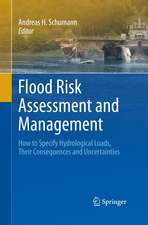Water Quality Modelling for Rivers and Streams: Water Science and Technology Library, cartea 70
Autor Marcello Benedini, George Tsakirisen Limba Engleză Paperback – 7 mar 2015
Advection, dispersion and concentrated sources or sinks of contaminants lead to the formulation of the fundamental differential equation of pollutant transport. Its integration, according to appropriate initial and boundary conditions and with the knowledge of the velocity field, allows for pollutant behaviour to be assessed in the entire water body. An analytical integration is convenient only in one-dimensional approach with considerable simplification. Integration in the numerical field is useful for taking into account particular aspects of water body and pollutants.
To ensure their reliability, the models require accurate calibration and validation, based on proper data, taken from direct measurements. In addition, sensitivity and uncertainty analysis are also of utmost importance.
All the above items are discussed indetail in the 21 chapters of the book, which is written in a didactic form for professionals and students.
| Toate formatele și edițiile | Preț | Express |
|---|---|---|
| Paperback (1) | 641.03 lei 6-8 săpt. | |
| SPRINGER NETHERLANDS – 7 mar 2015 | 641.03 lei 6-8 săpt. | |
| Hardback (1) | 644.95 lei 6-8 săpt. | |
| SPRINGER NETHERLANDS – 7 feb 2013 | 644.95 lei 6-8 săpt. |
Din seria Water Science and Technology Library
- 18%
 Preț: 950.96 lei
Preț: 950.96 lei - 15%
 Preț: 646.62 lei
Preț: 646.62 lei - 24%
 Preț: 796.92 lei
Preț: 796.92 lei - 18%
 Preț: 892.90 lei
Preț: 892.90 lei - 18%
 Preț: 953.65 lei
Preț: 953.65 lei -
 Preț: 459.43 lei
Preț: 459.43 lei - 18%
 Preț: 742.31 lei
Preț: 742.31 lei - 18%
 Preț: 1226.11 lei
Preț: 1226.11 lei - 18%
 Preț: 956.50 lei
Preț: 956.50 lei - 18%
 Preț: 1225.48 lei
Preț: 1225.48 lei - 18%
 Preț: 776.40 lei
Preț: 776.40 lei - 18%
 Preț: 1014.76 lei
Preț: 1014.76 lei - 18%
 Preț: 957.13 lei
Preț: 957.13 lei - 24%
 Preț: 744.68 lei
Preț: 744.68 lei - 18%
 Preț: 953.35 lei
Preț: 953.35 lei - 18%
 Preț: 1108.04 lei
Preț: 1108.04 lei - 18%
 Preț: 1121.65 lei
Preț: 1121.65 lei - 15%
 Preț: 644.63 lei
Preț: 644.63 lei - 18%
 Preț: 1116.71 lei
Preț: 1116.71 lei - 18%
 Preț: 731.91 lei
Preț: 731.91 lei - 24%
 Preț: 744.33 lei
Preț: 744.33 lei - 18%
 Preț: 894.46 lei
Preț: 894.46 lei - 18%
 Preț: 1020.74 lei
Preț: 1020.74 lei - 24%
 Preț: 945.42 lei
Preț: 945.42 lei -
 Preț: 553.51 lei
Preț: 553.51 lei - 24%
 Preț: 840.38 lei
Preț: 840.38 lei
Preț: 641.03 lei
Preț vechi: 754.15 lei
-15% Nou
Puncte Express: 962
Preț estimativ în valută:
122.67€ • 131.17$ • 102.27£
122.67€ • 131.17$ • 102.27£
Carte tipărită la comandă
Livrare economică 18 aprilie-02 mai
Preluare comenzi: 021 569.72.76
Specificații
ISBN-13: 9789401783798
ISBN-10: 9401783799
Pagini: 308
Ilustrații: XVIII, 288 p. 94 illus., 10 illus. in color.
Dimensiuni: 155 x 235 x 17 mm
Greutate: 0.44 kg
Ediția:2013
Editura: SPRINGER NETHERLANDS
Colecția Springer
Seria Water Science and Technology Library
Locul publicării:Dordrecht, Netherlands
ISBN-10: 9401783799
Pagini: 308
Ilustrații: XVIII, 288 p. 94 illus., 10 illus. in color.
Dimensiuni: 155 x 235 x 17 mm
Greutate: 0.44 kg
Ediția:2013
Editura: SPRINGER NETHERLANDS
Colecția Springer
Seria Water Science and Technology Library
Locul publicării:Dordrecht, Netherlands
Cuprins
Preface.- 1. Water Quality in the context of Water Resources Management.- 2. Basic notions.- 3. Mathematical interpretation of pollution transport.- 4. Fundamental expressions.- 5. Dispersion in rivers and streams.- 6. The biochemical pollution.- 7. The most frequent pollutants in a river.- 8. Temperature dependence.- 9. Application of the general differential equations.- 10. The steady-state case.- 11. Interpretation in finite terms.- 12. Progress in numerical modelling: the Finite Difference Method.- 13. The finite element method.- 14. The finite volume method.- 15. Multi-dimensional approach.- 16. Thermal Pollution.- 17. Optimisation models.- 18. Model calibration and validation.- 19. Water Quality Measurements and Uncertainty.- 20. Model reliability.- 21. Final thoughts and future trends.- Appendix.- Index.
Recenzii
From the reviews:
“This title provides a comprehensive and detailed primer to water quality modelling. … useful for water planners and managers, watershed users, postgraduate students and professionals in the fields of environmental planning, water quality, civil engineering and catchment management. It is well written and structured. The reader will find this book as a good basis for understanding water quality modelling and very beneficial in his professional life.” (D. Alexakis, European Water, Issue 41, March, 2013)
“This title provides a comprehensive and detailed primer to water quality modelling. … useful for water planners and managers, watershed users, postgraduate students and professionals in the fields of environmental planning, water quality, civil engineering and catchment management. It is well written and structured. The reader will find this book as a good basis for understanding water quality modelling and very beneficial in his professional life.” (D. Alexakis, European Water, Issue 41, March, 2013)
Textul de pe ultima copertă
The main objective of the Water Framework Directive in the European countries is to achieve a “good status” of all the water bodies, in the integrated management of river basins. In order to assess the impact of improvement measures, water quality models are necessary. During the previous decades the progress in computer technology and computational methods has supported the development of advanced mathematical models for pollutant transport in rivers and streams. This book is intended to provide the fundamental knowledge needed for a deeper understanding of these models and the development of new ones, which will fulfil future quality requirements in water resources management. This book focuses on the fundamentals of computational techniques required in water quality modelling.
Advection, dispersion and concentrated sources or sinks of contaminants lead to the formulation of the fundamental differential equation of pollutant transport. Its integration, according to appropriate initial and boundary conditions and with the knowledge of the velocity field, allows for pollutant behaviour to be assessed in the entire water body. An analytical integration is convenient only in one-dimensional approach with considerable simplification. Integration in the numerical field is useful for taking into account particular aspects of water body and pollutants.
To ensure their reliability, the models require accurate calibration and validation, based on proper data, taken from direct measurements. In addition, sensitivity and uncertainty analysis are also of utmost importance.
All the above items are discussed in detail in the 21 chapters of the book, which is written in a didactic form for professionals and students.
Advection, dispersion and concentrated sources or sinks of contaminants lead to the formulation of the fundamental differential equation of pollutant transport. Its integration, according to appropriate initial and boundary conditions and with the knowledge of the velocity field, allows for pollutant behaviour to be assessed in the entire water body. An analytical integration is convenient only in one-dimensional approach with considerable simplification. Integration in the numerical field is useful for taking into account particular aspects of water body and pollutants.
To ensure their reliability, the models require accurate calibration and validation, based on proper data, taken from direct measurements. In addition, sensitivity and uncertainty analysis are also of utmost importance.
All the above items are discussed in detail in the 21 chapters of the book, which is written in a didactic form for professionals and students.
Caracteristici
Explains the basics and methods for advanced simulation models of pollutant transport in rivers and streams Written in a didactic form for professionals and students Careful explanation with illustrations and examples Covers fundamentals of computational techniques required in water quality modelling Includes supplementary material: sn.pub/extras



























